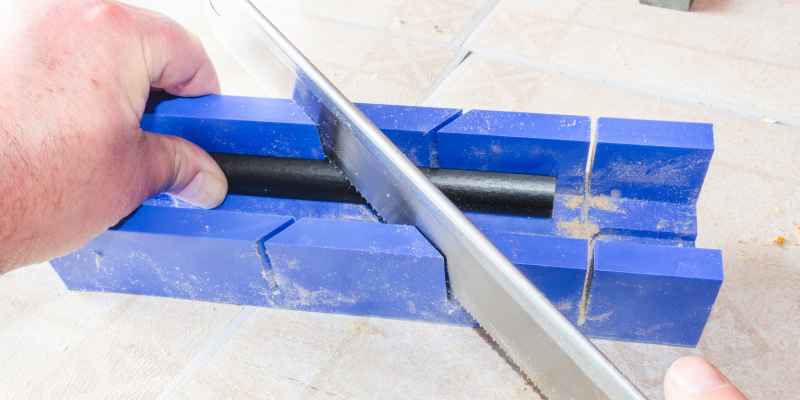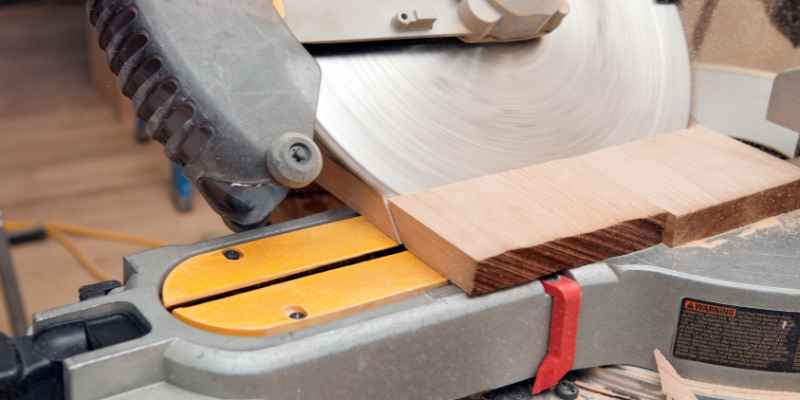To cut angles without a miter saw, you can use a circular saw and a protractor to mark and cut the desired angle accurately. Alternatively, you can create a simple angle-cutting jig using a scrap piece of wood and a handsaw for precision.
These methods provide efficient solutions for making angled cuts without the need for a miter saw. Cutting angles is a common woodworking task, but not everyone has access to a miter saw. Whether you’re a DIY enthusiast or a professional carpenter working on a job site without a miter saw, you need alternatives for cutting angles accurately.
Fortunately, there are a couple of techniques you can employ to achieve precise angled cuts without a miter saw. This article will explore two effective methods that will help you cut angles with ease using basic tools like a circular saw, protractor, scrap wood, and a handsaw. So, if you’re in a situation where a miter saw is unavailable, keep reading to learn how to cut angles efficiently.
Using A Circular Saw
When it comes to making angled cuts without a miter saw, using a circular saw can be a versatile and effective alternative. With careful technique and the right setup, you can achieve precise cuts for various projects. Let’s delve into the process of cutting angles with a circular saw.
Straight Cuts
For straight cuts, it’s important to use a straight edge or a guide to ensure accuracy. Simply measure and mark the angle you need, then clamp the guide in place to follow as a cutting reference. It’s crucial to maintain a steady hand and use firm pressure to guide the circular saw along the designated path. This method can yield clean and precise straight angle cuts without the need for a miter saw.
Bevel Cuts
When it comes to bevel cuts, adjusting the circular saw’s base to the required angle is essential. Start by setting the bevel angle on the saw, then carefully align and secure the workpiece before making the cut. Ensure proper support for stability and safety. Take your time and maintain a steady hand to achieve accurate bevel cuts, allowing you to create angles for various woodworking and construction projects.

Using A Table Saw
Cutting angles without a miter saw can be achieved using a table saw. With proper measurements and technique, you can easily achieve precise angled cuts for your woodworking projects.
Straight Cuts
When it comes to cutting angles without a miter saw, using a table saw is a versatile alternative that can produce precise results. The table saw provides a sturdy platform for guiding and cutting materials at various angles. Whether you need to make straight cuts or miter cuts, the table saw can be your go-to tool.
To make straight cuts using a table saw, follow these steps:
1. First, ensure that you have the correct blade for the material you are cutting. A fine-toothed blade is ideal for cutting wood, while a carbide-tipped blade works best for cutting through other materials like plastic or metal.
2. Measure and mark the angle you want to cut on your material. Use a measuring tape and pencil to ensure accuracy.
3. Adjust the table saw blade to the desired angle. Most table saws have a miter gauge that allows you to adjust the blade to the desired angle. Set the angle according to your measurement.
4. Position the material against the fence of the table saw. The fence helps keep the material steady while you make the cut. Ensure that the material is aligned with the marked angle.
5. Start the table saw and slowly push the material through the blade. Use a push stick or push block to keep your hands at a safe distance from the blade.
6. Continue pushing the material through until the cut is complete. Let the blade do the work and avoid pushing too hard which may cause splintering or kickback.
Miter Cuts
In addition to making straight cuts, a table saw can also be used to make miter cuts. Miter cuts are angled cuts made across the width of the material. They are commonly used for creating frames, molding, or other decorative elements.
To make miter cuts using a table saw, follow these steps:
1. Set the table saw blade to a 45-degree angle using the miter gauge. This angle is commonly used for making miter cuts, but you can adjust it if you need a different angle.
2. Position the material against the fence and align it with the desired angle.
3. Hold the material firmly against the fence and start the table saw.
4. Slowly push the material through the blade, keeping it pressed against the fence to maintain a smooth cut.
5. Continue pushing until the cut is complete.
Remember to always prioritize safety when working with a table saw. Wear eye protection, keep your hands away from the blade, and follow the manufacturer’s instructions for operating the saw.
By using a table saw for cutting angles, you can achieve accurate results without the need for a miter saw. Whether you are making straight cuts or miter cuts, the table saw can be a valuable tool in your woodworking arsenal.
Using A Jigsaw
A jigsaw is a versatile power tool that can be used to make precise and angled cuts in various materials, including wood, plastic, and metal. It is an excellent alternative to a miter saw when it comes to cutting angles without the need for expensive equipment. With the right technique and precautions, you can achieve clean and accurate cuts using a jigsaw.
Straight Cuts
To make straight cuts using a jigsaw:
- Secure your workpiece firmly with clamps or a vice to prevent any movement during cutting.
- Choose an appropriate jigsaw blade with fine teeth for smoother cuts.
- Align the jigsaw blade with your desired cutting line, ensuring it is perpendicular to the workpiece.
- Start the jigsaw and guide it steadily along the cutting line, applying gentle pressure.
- Keep the jigsaw steady and avoid excessive force to prevent the blade from bending.
- Continue cutting until you reach the end of the line, maintaining a smooth and even pace.
- Upon completing the cut, allow the blade to come to a complete stop before removing it from the workpiece.
By following these steps, you can make precise and clean straight cuts using a jigsaw.
Bevel Cuts
Bevel cuts are angled cuts made across the thickness of the workpiece. The process of making bevel cuts with a jigsaw is similar to straight cuts, with a slight adjustment:
- Secure your workpiece as mentioned earlier to ensure stability.
- Set the jigsaw baseplate to the desired bevel angle, which can typically be adjusted by loosening a screw.
- Align the jigsaw blade with your cutting line at the desired angle, ensuring it is perpendicular to the workpiece.
- Start the jigsaw and carefully guide it along the bevel cutting line, maintaining a steady pace.
- Pay close attention to the angle and adjust as necessary to achieve the desired bevel cut.
- Complete the cut and let the blade stop completely before removing it from the workpiece.
These steps will help you create accurate bevel cuts using a jigsaw, allowing you to tackle angled projects effectively.
Using A Hand Saw
When it comes to cutting angles without a miter saw, using a hand saw can be a practical and effective method. While a miter saw offers precision and efficiency, a hand saw can also achieve accurate cuts with the right technique and attention to detail.
Straight Cuts
To make straight cuts using a hand saw, ensure that the material is securely clamped or held in place. Use a carpenter’s square to mark the cutting line, guiding the hand saw along the line with steady, even strokes. Maintain a firm grip on the saw and maintain a consistent angle to achieve clean and precise straight cuts on the material.
Miter Cuts
For miter cuts, it’s important to measure and mark the angle accurately on the material. Secure the material in place and make the initial straight cut along one side of the angle. Then, carefully guide the hand saw to create the mitered angle, ensuring smooth and controlled movements to achieve the desired angle.

Tips For Accurate Cuts
Learn how to achieve precise cuts without a miter saw using simple tools and techniques. Gain confidence in cutting angles accurately with these practical tips and improve your woodworking skills. Master the art of cutting angles without relying on a miter saw, and elevate your DIY projects with professional-grade results.
When it comes to cutting angles without a miter saw, achieving accurate cuts can be a challenging task. However, by following a few simple tips, you can ensure precise cuts each time:
Measuring And Marking
Accurate measurements and markings are crucial for achieving precise cuts. Before beginning your project, take the time to measure and mark the angles correctly. Here’s how:
- Use a measuring tape to determine the length of the angled cut required.
- Mark the starting point of the cut on the workpiece using a pencil.
- Measure the desired angle using a protractor or angle finder tool.
- Using the measurements, mark the endpoint of the cut on the workpiece.
By taking precise measurements and making accurate markings, you’ll have a clear guide for your cuts, ensuring the desired angle is achieved.
Clamping The Workpiece
Securing the workpiece firmly in place is essential for achieving accurate cuts without a miter saw. To ensure stability and prevent the piece from moving, follow these steps:
- Choose a suitable clamp, such as a bar or C-clamp, depending on the size and shape of the workpiece.
- Position the clamp tightly against the workpiece, ensuring it holds it securely.
- Place additional clamps at strategic points along the workpiece to provide extra support and prevent any movement.
By clamping the workpiece correctly, you can maintain stability throughout the cutting process, reducing the risk of mistakes or inaccuracies.
Using A Guide
Utilizing a guide can significantly enhance the accuracy of your cuts. There are various options available, such as a straight edge or a scrap piece of wood. Follow these steps to use a guide effectively:
- Choose a guide that is straight and smooth.
- Position the guide along the marked cutting line, aligning it with the desired angle.
- Hold the guide securely in place.
- With the guide acting as a reference, use a suitable cutting tool, such as a circular saw or handsaw, to make the cut along the guide.
Using a guide ensures that your cuts stay on track, allowing you to achieve precise angles without a miter saw.
Conclusion
Cutting angles without a miter saw can be done effectively with the right techniques. By using alternative tools like a circular saw or a handsaw and mastering the correct cutting methods, you can achieve precise angles for your woodworking projects.
With a bit of practice and patience, you can confidently tackle angle cuts without the need for a miter saw.


